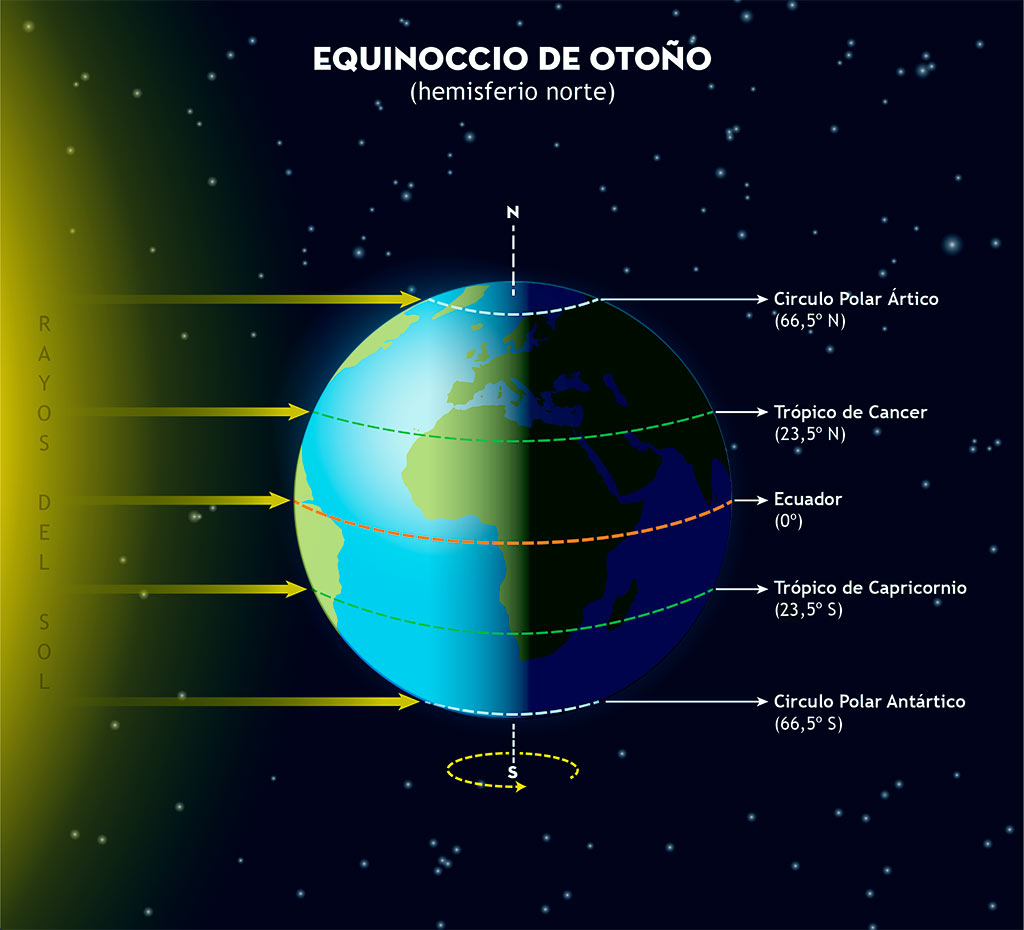El otoño
Inicio del otoño
El otoño de 2025 en el hemisferio norte comenzará el día 22 de septiembre a las 20 horas 19 minutos hora oficial peninsular según cálculos del Observatorio Astronómico Nacional (Instituto Geográfico Nacional - Ministerio de Transportes y Movilidad Sostenible). Esta estación durará aproximadamente 89 días y 21 horas, y terminará el 21 de diciembre con el comienzo del invierno.
El inicio del otoño en el hemisferio norte está definido por el instante en que la Tierra pasa por el punto de su órbita desde el cual el centro del Sol cruza el ecuador celeste en su movimiento aparente hacia el sur. El día en que esto sucede la duración del día y la noche prácticamente coinciden. A esta circunstancia se la llama también equinoccio de otoño.
En el momento en que el otoño comienza en el hemisferio norte, en el hemisferio sur comienza la primavera.
El cielo durante el otoño de 2025
Al comienzo del otoño, el cielo tras la puesta de Sol, tendrá a Marte y Saturno como únicos planetas visibles. Mercurio se incorporará unos días después del comienzo de la estación. Mercurio y Marte se podrán ver hasta mediados de noviembre.
Los amaneceres, por el contrario, van a permitir ver a Venus y Júpiter durante toda la estación. El primero podrá verse hasta finales de noviembre, cuando hará su aparición Mercurio.
En cuanto a las estrellas y constelaciones visibles al anochecer en otoño, destacará el triángulo de verano, formado por Deneb en el Cisne, Vega en Lira y Altair en el Águila, que seguirá siendo visible durante la primera parte de la estación, aunque gradualmente a menor altura sobre el horizonte oeste. A medida que avancen los meses, veremos surgir por el este las constelaciones de Pegaso, Andrómeda y Perseo, y al final de la estación aparecerán las constelaciones de Tauro y Orión, que alcanzarán su máximo esplendor durante las noches de invierno.
Otros fenómenos de interés astronómico durante el otoño de 2025 serán las lluvias de meteoros de las dracónidas, cuyo máximo se espera hacia 8 de octubre, las oriónidas, con máximo hacia el 21 de octubre, las leónidas, con máximo hacia el 17 de noviembre, y las gemínidas, con máximo hacia el 14 de diciembre. Las lunas llenas del otoño tendrán lugar el 7 de octubre, el 5 de noviembre y el 5 de diciembre.
Cambio de hora
Aunque tanto el Parlamento Europeo como la Comisión se han pronunciado a favor de eliminar los cambios de hora en el futuro, todavía no existe una decisión definitiva al respecto. Por ello, durante 2025 seguirá en vigor el tradicional cambio de hora que tiene lugar el último domingo de octubre. Ese día, el 26 de octubre, a las 3 de la madrugada hora peninsular retrasaremos los relojes una hora para volver a marcar las 2. En Canarias, las 2 de la madrugada pasarán a ser la 1.
Algunas curiosidades sobre el otoño
El inicio del otoño puede darse, a lo sumo, en cuatro fechas distintas del calendario (del 21 al 24 de septiembre). A lo largo del siglo XXI el otoño se iniciará en los días 22 y 23 de septiembre (fecha oficial española), siendo su inicio más tempranero el del año 2096 y el inicio más tardío el de 2003. Las variaciones de un año a otro son debidas al modo en que encaja la secuencia de años según el calendario (unos bisiestos, otros no) con la duración de cada órbita de la Tierra alrededor del Sol.
El inicio del otoño es la época del año en que la longitud del día se acorta más rápidamente. A las latitudes de la península, el Sol sale por las mañanas más de un minuto después que el día anterior, y por la tarde se pone más de un minuto antes. Como consecuencia, al inicio del otoño, el tiempo en que el Sol está por encima del horizonte disminuye casi tres minutos cada día.
Para más información sobre los fenómenos astronómicos del año se puede consultar el Anuario del Observatorio Astronómico, que publica el Instituto Geográfico Nacional.
Información proporcionada por el Observatorio Astronómico Nacional (IGN, Ministerio de Transportes y Movilidad Sostenible). Se autoriza la reproducción total o parcial citando su procedencia.


